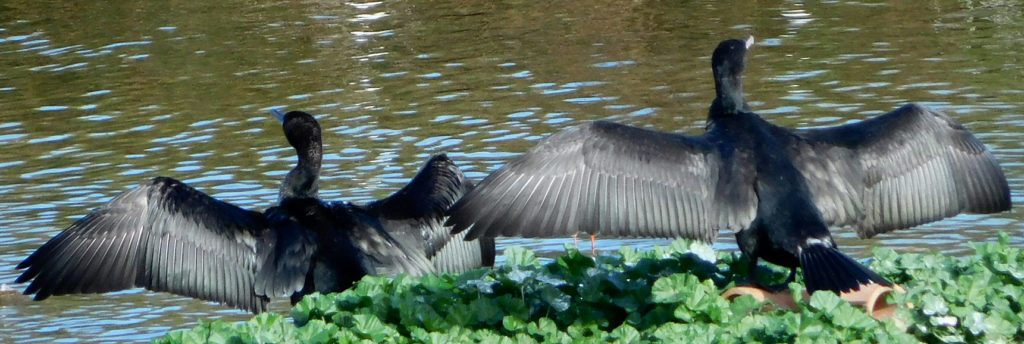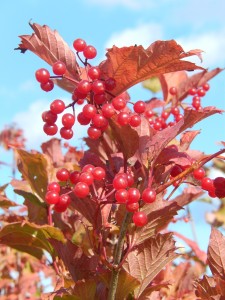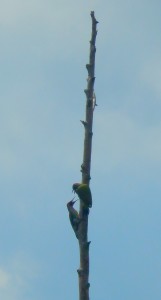


Spring is full of surprises, and this Heron, nesting not in a colony up in the trees, but all alone in an abandoned Swan’s nest in a reedbed, is certainly one of them. The London Wetland Centre this morning also boasted a mass of Blackcaps in the “Wildside” woodland, with at least three males and a female actually in sight at once, along with an obliging Chiffchaff giving me an excellent view, and a characteristically invisible Cetti’s Warbler, shouting out its amazingly loud call. The Silver Birches were in wonderfully fresh green leaf, their bark crisply white against the clear blue of the sky.


Yesterday, round at Wraysbury Lakes, the same set of three warblers sang, but more elusively. The most delightful surprise was a Treecreeper, not only creeping up the willow branches, but singing its sweetly plaintive little song. This used to be rendered, rather tweely, as “Tree, tree, tree, once more I come to thee”, which does capture the length and rhythm of the song. It is not unlike the Chaffinch’s song, if you know that, but without the twiddly “tissy-cheeooo” ending, and not so firm and harsh. One of the Blackcaps, in the thorn-scrub area, had a fine mimetic song. Out on Horse Hill, the first two Swallows of the year flitted overhead, a solitary Kestrel beat its way against the wind, and half a dozen Jackdaws played and chased in the air, for all the world like a gang of naughty schoolboys.
It was too sunny and warm to sit at a desk writing, so I took bicycle and binoculars and went along the Thames path to the Wetland Centre. Even in a T-shirt it was warm work, feeling more like an English July (ok, that’s not saying much) than the last day of November .

Inside the Centre I passed some diminutive witches and warlocks: they seemed to be sweating uncomfortably inside their costumes. I took a swig of water and cooled off in a hide; two rare migrants, Green Sandpipers, bobbed daintily at the end of one of the little islands, dwarfed by a Black-Headed Gull and a Moorhen, neither of them particularly large birds. Their habit is not unlike that of the Common Sandpiper, but they lack the white streak that rises in front of the wing. One of them took flight, its slender dark wings and white belly giving it something of the look of a rather large and clunky House Martin. It felt very odd to be watching autumn migrants on such a summery day.
Over at the wader scrape, a Little Egret strutted and once fluttered across the shallow water; it is an uncommon visitor here, though becoming more usual along the south coast marshes and estuaries.
A Green Woodpecker bounded over the grazing marsh in its distinctive undulating flight, its red cap and green body showing beautifully in the hot sunshine, with a loud laughing call in case anybody was in any doubt what it was.
A Cetti’s Warbler sang its bold short song, Chwit-i-pit-i-pit, Chwit-i-pit-i-pit, as usual invisible deep in a reedbed.
Out on the open water, numbers of winter ducks are (oddly, given the summery weather) building up; several Shovelers dabbled; some dozens of Wigeon grazed; a few Teal, the drakes in glorious colour, swam nimbly about with some Gadwall.
Even on the way home, I had no need of a pullover. The BBC weather report confirmed what everyone instinctively knew: it was the warmest 31st of October ever recorded in Britain, with an astonishing 23.6 Celsius in London. Of course, a cold front is forecast.
P.S. The next morning was grey and rainy, autumn on the way. Two large grey Mistle Thrushes flew overhead, rasping out their wintry calls, like a boy blowing over a comb covered in tracing paper.
P.P.S. Four days later, after a clear starry night, the sun rose over a chilly town on a fine November morning. It was winter.

Today a brisk southwesterly wind blew the ragged clouds away, and it suddenly felt very much like autumn. The willows have lost many of their leaves, while other trees are still fully clad in green. Down at the Wetland Centre, the Guelder Roses were resplendent in scarlet: the photo is exactly as taken.
Down on the grazing marsh, a few migrant birds were giving the resident birdwatchers a treat. The Peacock Tower echoed to excited calls as a Whinchat perched on a faraway reed to the left, a Jack Snipe bobbed obligingly among some dead reeds to the front, and a Stonechat perched momentarily on a reed to the right. To my own surprise I saw all of them, even confirming that the Jack Snipe was bobbing up and down and had a dark stripe down the centre of its head. When it sat still it was marvellously hard to see, even in a telescope zoomed in and centred on the bird, its disruptive patterning doing an excellent job of breaking up its shape and matching the light and shadow of the vegetation around it.
Round on the wildside of the reserve, a few (Migrant) Hawker dragonflies and some Common Darters were still flying; and overhead, five House Martins, presumably on their way down south from somewhere far to the north, were busy refuelling on the many small insects flying over the water.

Aah. Ducks with ducklings. Coots with Cootlings. Geese with Goslings. Swans with Cygnets. Moorhens with … chicks. Whatever the charmingly mediaeval diminutive nouns, it was a day for walking around the London Wetland Centre, enjoying the ‘sunny spells’ and the bright display of wild flowers, artfully seeded, and delighting in Mother Nature’s ability to conjure up fluffy sentimental feelings about roughly duck-shaped balls of fluffy down feathers.

I’d gone alone to see if there were any interesting dragonflies, but there weren’t many about: a warmer day is always better. But there was a Black-Tailed Skimmer basking on one of the ‘wildside’ paths.

Apart from that, I glimpsed one Hawker dragonfly – probably a Hairy dragonfly, as the only kind other than the Emperor seen there in the past month; and there were plenty of Common Blue and Bluetail damselflies about.
As for butterflies, it was alarmingly empty: a couple of meadow browns, a small white or two, and a female brimstone the highlight. My alarm at the lack of insects in general in England is growing. If it’s neonicotinoids – hot on the heels of all the earlier insecticides, many now rightly banned for their destructive side-effects on wildlife – then we are watching a manmade calamity. The BBC noted that some ditch water was toxic enough to be used, just as it was, as an insecticide spray for crops. The effect of that on dragonflies can only be imagined: a sad thing, as (living in rivers and ponds rather than on farmland) they have to some degree escaped the disaster that has all but eliminated our farmland birds, bees and butterflies.
But on a dead tree, wildside, was another fluffy-duckling sight, this time from a distinctly arboreal bird.

Two Green Woodpeckers, presumably a parent and a newly-fledged juvenile, were clinging to a dead tree, the parent a little higher up, the youngster apparently begging for food with open beak. The family drama went on for several minutes.

Tiny wildlife shows were visible on the flowers: here, two hoverflies of different species, busy being Batesian mimics of dangerously stinging wasps (but harmless as doves) are feeding, slow and relaxed in the sunshine, on the small flowers in a Great Burnet’s flowerhead. They didn’t seem at all bothered by each other, or by any risk from predators. But despite their glorious colours, it was duckling day today.